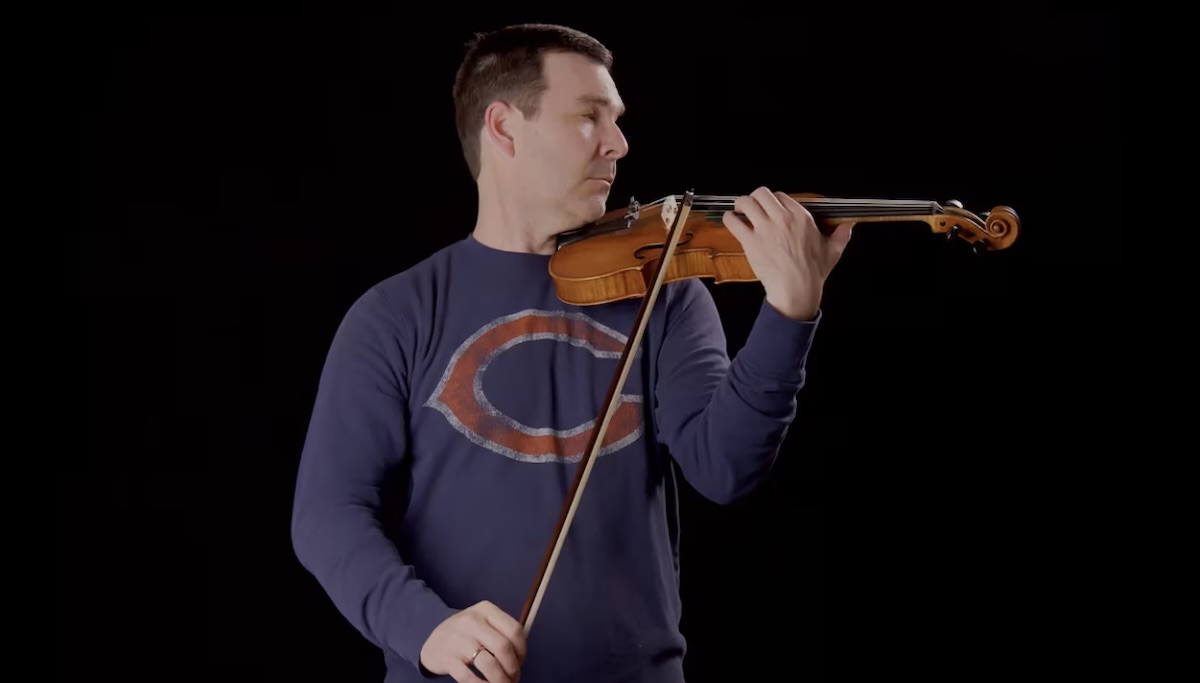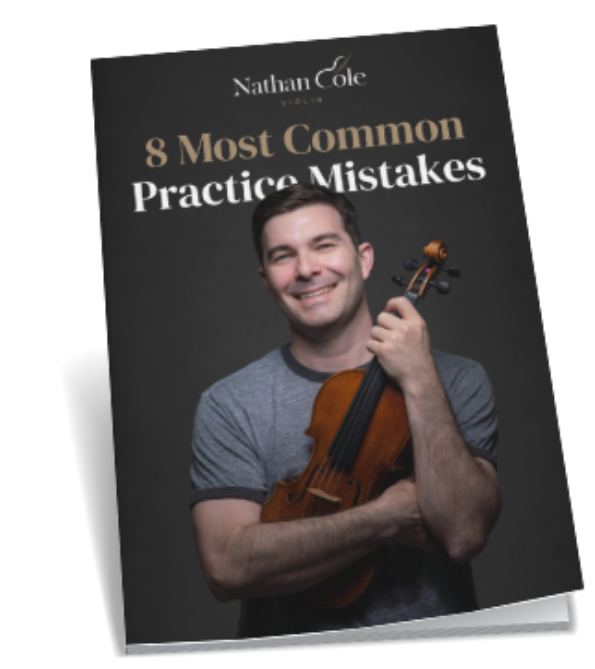Rid yourself of damaging left hand tension: find your MVP

I recently got an email from a longtime reader and friend asking for help with one of those fast and loud pieces that never seems to give you a break. He said his arm was getting tired, and I assumed he was talking about the bow arm. But actually it was the left arm that was getting fatigued!
We’ve been able to make a real difference in just a few days using a technique I adapted from Simon Fischer. I call it “Finding your MVP”: your Minimum Viable Pressure. This is an exercise I turn to as soon as I feel like a passage is “stuck”. In other words, I think I’m doing everything correctly, but it just doesn’t feel natural or easy.
You probably know already that extra tension in your playing can hurt you over time. I’m talking about physical pain and injury, not just the loss of speed and accuracy that are the first indicators of tension. So give this practice technique a try, and see if you have any extra left-hand tension that you can shed!
You can put this technique to use on any passage, and it only takes a minute. Give it a try and let me know how it works for you in the comments!
Comment section
31 thoughts on “Rid yourself of damaging left hand tension: find your MVP”
Leave a Reply

Scales: The Road
to Repertoire
Even if you’ve never played a scale before, violinist Nathan Cole of the Los Angeles Philharmonic will guide you through scale routines that meet you where you are, and build progressively alongside your playing.








This is great! Thanks so much for posting this video.
Nate,
I am a recent subscriber to your blog. I am a professional violinist and am in the 1st violin section of the Kennedy Center Opera House Orchestra. This is my 40th year, having started at age 40! Does that tell you something? I am finding your information absolutely fascinating and an answer to my struggle to keep learning. Obviously, I am doing something right to be playing professionally at my age, but aside from that, you address many issues that are prevalent in someone who is aging and still trying to play at a high level. Also, I need variety in my practice, as I have been at it for a very long time and want to stay fresh and engaged in what I do. Thank you so much for all that you take the time to give to those of us who still need it put are, perhaps, too old to be studying actively with someone else. I believe that you probably know my cousin – David Garrett, a cellist in the LA Philharmonic.
Great, thanks so much for sharing this! What a career! And I see David all the time.
Wow, that’s wonderful. How did you do that as an adult learner? I’d love to play in a top orchestra.
Thanks Nate! Another invaluable tool for us.
Great tips, Nathan!
I’m just curious to know if you consider any situation where great left hand pressure is useful.
Thank you for your posts,
Márcio
Not really… at least never more than necessary. Basically, the thicker strings take more pressure than the thinner ones to stop, so loud G string passages will need more. What you’re really after is speed! You need to get from “off the string” to “just enough pressure” as fast as you can so that the string is stopped completely and immediately. I think that speed is often confused with pressure. But just like the pianists, we want that great speed but only driving down as far as necessary–not into the key frame, so to speak.
Do finger speed and finger pressure have different roles though? I’ve thought that fast finger speed, in the lifting and dropping of fingers, helps minimize fuzziness in the sound as vibrations on the string change to a different string length. But in contrast, finger pressure is what you actually need to have a pure sound for each note. So speed clears up the beginnings and ends of notes, like passing of a baton between them, while pressure clears up the actual notes. But speed always works with pressure so that if the passing between notes feels clear and easy, the pressure we release for each note is lighter and closer to the MVP. Is this an accurate way of thinking of it?
Thanks so much for these videos and articles!! They’re so great and fun to learn from!! 🙂 🙂
Absolutely! You need to get from no pressure to MVP (and vice versa) as fast as possible, so that’s where speed comes in. It’s possible to have slow fingers that press too hard (the worst of all worlds!) but more common is fingers that press harder the faster they move or the louder the passage. So this exercise is meant to break that habit and build awareness.
Maybe one thing to watch out for is left hand pizzicato. Even though we are trying to only use minimum pressure, the MVP for the stopped finger is much higher than before, like around an 8 I guess. 🙂
That would be an exception, I agree, and perhaps for normal pizzicato as well. The finger has to be strong enough to resist the sideways pull of the pizz-ing finger.
This was super-helpful – left hand pressure has always been a problem for me – I hope this method will help me clear that up over time. Thanks for posting it!
Yes, let me know how it works!
Thanks for sharing this blog
Hello Nathan,
a tension is my big problem. Exactlier tension between my jaw and my left shoulder and tension between upper and lower jaw, mostly when I vibrate. Recently my arm and shoulder hurts me a lot of, and I think that it is because of tension in jaws and my left shoulder. When I´m not vibrating and playing straight tone, I am mostly already loose, but with vibrato it is worse. Could recommend me some exercise to release my jaws and arm or did you try some exercise, which could help me?
Thank you for your videos and ideas,
Martin
Yes, that is a common place for tension! The single biggest thing you could do would be to do some practice with the chin completely off the chin rest. It will feel very strange at first, but this way you will not be able to clamp down with your head on the instrument, which is undoubtedly causing this tension. You will need to develop some support of the instrument in the left hand/arm for this to work. Then, when you put the chin back on the rest for “normal” playing, see that you keep the minimum pressure on the rest.
As for the vibrato itself, I made a video on that subject. I hope that may help you!
Thank you for sharing this video,Nate.
But what would you say about my situation. I’m professional violinist from Russia. Now live in Croatia. There is a huge problem with the left hand. It’s tendinitis already (i’m 29years old). So, when the inflammation is really painful i stop playing. When it is ok, then playing. practicing a lot. Working in the orchestra… Do you maybe know any excercises to do with the hand right after the playing? Or any other secrets?:)
I sympathize with your situation! Usually the only thing to do in the beginning is to rest. Then to bring back the playing gradually. It helps if you don’t try to go too fast first thing in the morning, just some easy playing for a while. It can also be helpful to soak the hand and arm in warm water with epsom salts. But long-term, it will be best to find the source of your particular tension.
Hi Nate
First of all thanks for enormous contribution you are making globally to help violinist community get better and to be brought closer. Truly impressive.
I have injured my left thumb for the first time in my life playing violin and I think I have maybe done it practicing the repeated A major arpeggio (C# on the g string A on the d string high A on the a string and open e string) in Arvo Part’s fratres opening movement . For me this is a bit of a stretch and I can feel the tension in my forearm and thumb yet the chord is held quite a bit in that movement and I haven’t figured out a way to release the tension.
Any tips in this situation?
I know, that stretch lasts a while… sometimes the only help is rest once something is aggravated. When you go back to it, make sure your hand is actually in 4th position (so that the 4 doesn’t have to reach up) and reach 1 and 2 back. Especially when it’s quiet, you can also get away without totally pressing the strings all the way down.
Thank you, Nate
Hi Nathan,
Thank you so much for this video. I’ve had arm tension on and off for about a year. I’ve played for some of the finest players and no one could spot a flaw in my technique. My teacher even suggested that perhaps it wasn’t related to playing. I’m a violist, and I was starting to wonder if it was the size of my viola, until I realized I felt the same way after playing the violin. (A tightness in my forearm, not usually painful, but starting to become so.) I finally admitted to myself that I was developing an injury and took the last three weeks off. After trying these exercises I’ve realized that I’ve been pressing down wayyyy to hard. Even when I reduce my pressure to what I’d consider a 3 or 4, I find my strings are sounding normally, and have trouble maintaining the scratchy sound between harmonics and real playing. This is so eye opening and I look forward to what making this change will do for me!
I have two questions for you: First, do you find yourself not bringing the string all the way to the fingerboard, especially in higher positions? The same tension in first position that yields a scratchy sound seems to be more than enough in high positions. Second, have you experimented with string gauges, and how have you found it affects left hand pressure? I use standard gauge Obligato strings but I’ve thought about trying the weich gauge. It’s kind of an expensive experiment so I thought I’d see what you say first.
Thanks again!
Hi Susan, glad to know you’re on the way to finding the right amount of left-hand pressure. That hidden tension can really sneak up on you! As far as higher positions, in theory you should need more pressure up there to fully stop the string. But it’s also true that depending on how loud you’re playing (how much bow pressure, a separate issue!) you may not need to fully stop the string up there in order for the note to come out. So ultimately you’ll just have to use your ear to determine what’s coming out as “pure” sound. Always the minimum necessary pressure.
For string gauges, I haven’t done much experimenting in a while. Kind of like Goldilocks, when I tried lighter I found the sound choked under what I considered normal bow pressure, and heavy was too slow to speak and didn’t ring as much. It depends on your instrument. I do now use a heavy gauge E because that seems to match the other strings better and my violin likes the tension on that side apparently. But as to whether it would help the finger pressure issue, my guess is that it might but not too much. Much more impact will be the changes you make to your own habits, I’m sure.
Best of luck!
I’m three years late, but my left hand gets really sore when I play studies or scales in one fixed position, I’d asked my teacher about it, but she wasn’t sure what the problem was, but I tried playing one of the passages reducing the pressure in my hand, and it immediately relieved the pain! I hadn’t realised how much tension I carry in my hand. Thanks for posting this 😀
Great, thanks for sharing and this should make a big difference for you going forward!
This is great stuff and extremely helpful! One of the issues I encounter is that the balance of my left hand is weighted toward the 1st finger. In essence, the fingers aren’t equally balanced such that the 1st finger has way too much pressure and the 4th doesn’t have enough. Any tips on how to even out the balance/pressure between fingers? Even when trying to apply no pressure in the left hand, my tendency is to still use more pressure on the 1st finger than the others and equalizing everything is a challenge.
That can sometimes happen if the first-finger side of the hand is much closer to the neck of the instrument. Of course it will be closer than the 4th finger side will, but you can look at getting the 4 side a bit closer. Or it might be that the left elbow is too far to the right, putting extra pressure on the 1.
This is a several year late comment, but I just found this and am hoping it might be helpful. Ive recently developed pain in the back of my left shoulder which I believe is probably being caused by the tension from having played without a shoulder rest for several years but still gripping the violin with a huge amount of force and barely any of the weight being held by the left hand. im really hoping its not anything serious though i’ll still be having it checked. Will the excercise here still apply for a situation like this? (there is also what i think is probably tension-caused pain in my left hand, usually during double-stop filled passages)
Hi Mika, it’s impossible to say much specific without seeing you (plus the fact that I’m not a doctor!) but certainly the way you describe having tried to support the instrument without a shoulder rest or much help from your left hand sounds like a recipe for pain. The MVP concept and exercises will help you to stay on top of how much tension is in your left hand, but you’ll still have to get used to supporting the instrument differently from before!
Hi Nathan. I am 95 years old. I only took violin lessons until I was 16. Put the violin away and in 1984 moved from Canada to Arizona, immigrated and was invited to join the Scottsdale Symphony Orchestra in the 1st section, played with that orchestra for 17 years. The orchestra was mainly good amateurs. Put the violin down for 20 years and about 1 year ago met an excellent player the same age as me. I just want to play better for myself before I pass on. I never took any music theory. I’m payed mostly by ear although I do read music. Trying to learn scales, the difference between sharps and flats, the various key signatures etc. love your scale package. Working on the Mendelssohn. I played the Andante when I was 16 as a soloist with accompaniment. Just was to learn the best I can.
Thanks for your interest.
Mac
I had a teacher who insisted on pounding/banginging fingers onto the fingerboard. I believe it to be damaging and causing slower fonger action and leafing to carpal tunnel.
I am going to work on these 20 levels with a Forte bow.